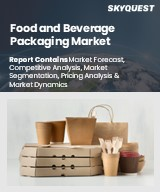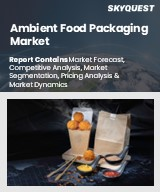
|
시장보고서
상품코드
1638854
즉석 조리 식품 포장 시장 : 기회, 성장 촉진요인, 산업 동향 분석, 예측(2024-2032년)Ready-to-Eat Food Packaging Market Opportunity, Growth Drivers, Industry Trend Analysis, and Forecast 2024 - 2032 |
||||||
세계 즉석 조리 식품 포장 시장은 2023년에 842억 달러로 평가되었으며, 2024년부터 2032년까지 연평균 복합 성장률(CAGR) 6.2%로 성장할 것으로 예측됩니다.
이 성장의 원동력이 되고 있는 것은 소비자의 기호의 변화, 기술 혁신, 지속가능성의 중시의 높아짐입니다. 기업 간(B2B) 섹터는 식품 제조업체와 택배 서비스가 편의성, 보존 기간 연장, 제품 신선도 및 안전성 향상을 제공하는 포장 솔루션을 요구합니다.
소비자의 건강 지향은 점점 높아지고 있으며, 유기농 및 플랜트 기반 RTE 식품의 영양 완전성을 유지하는 데 도움이 되는 포장에 대한 수요가 증가하고 있습니다. 또한, 환경에 대한 관심 증가를 반영하여 생분해성, 퇴비화 가능, 재활용 가능한 옵션 등 지속 가능한 포장 재료로의 이동이 두드러집니다. 센서가 장착된 스마트 포장 및 가스 대체 포장(MAP)과 같은 신기술은 식품 안전과 제품 수명을 향상시켜 시장 확대에 더욱 기여하고 있습니다.
시장은 포장 유형별로 경질, 연질, 반경질 범주로 구분됩니다. 그중에서도 연포장 분야는 CAGR 7%로 성장해 2032년에는 800억 달러에 달할 것으로 예측되고 있습니다. 파우치와 필름을 포함한 연 포장은 재료 기술의 첨단과 편의성을 요구하는 소비자 요구 증가로 인기를 끌고 있습니다. 이 솔루션은 제품 품질을 유지하고 안전성을 높이고 유통 기한을 연장하는 우수한 밀봉성을 제공하므로 식품 제조업체에게 매우 매력적입니다.
| 시장 범위 | |
|---|---|
| 시작 연도 | 2023년 |
| 예측 연도 | 2024-2032년 |
| 시작 금액 | 842억 달러 |
| 예측 금액 | 1,445억 달러 |
| CAGR | 6.2% |
용도별로는 즉석 조리 식품 포장 시장은 즉석 조리 식품, 즉석면, 스낵류, 과자류, 고기, 해산물, 과일, 야채 등으로 나눌 수 있습니다. 즉석 조리 식품이 시장을 선도해 2023년에는 34%의 점유율을 차지했습니다. 이 분야는 품질에 타협하지 않고 편리성을 요구하는 소비자의 욕구에 의해 현저한 성장을 이루고 있습니다. 이러한 다이어트의 신선도, 식감 및 맛을 유지하기 위해 고급 포장 기술이 사용되어 고품질의 즉석 조리 식품 옵션에 대한 수요 증가에 대응하고 있습니다.
북미는 즉석 조리 식품 포장의 최대 시장으로 2023년에는 35%의 점유율을 창출했습니다. 미국 시장은 편리하고 고품질의 식사 솔루션에 대한 소비자 수요 증가로 이익을 얻고 있습니다. 요리된 식품 포장은 식품의 안전성과 보존 기간의 연장에 중점을 두고 다양한 제품에 널리 사용됩니다. 첨단 포장 기업은 기술 혁신의 최전선에 서서 제품의 안전성과 신선도를 높이는 첨단 포장 솔루션을 지속적으로 개발하고 있습니다.
목차
제1장 조사 방법과 조사 범위
제2장 주요 요약
제3장 업계 인사이트
- 생태계 분석
- 밸류체인에 영향을 주는 요인
- 파괴
- 장래의 전망
- 제조업체
- 유통업체
- 이익률 분석
- 주요 뉴스와 대처
- 규제 상황
- 영향요인
- 성장 촉진요인
- 편의점 식품에 대한 소비자 수요 증가
- 포장 기술의 선진화
- 전자상거래 및 식품택배 서비스 확대
- 도시화의 진전과 가처분 소득 증가
- 지속가능성과 환경친화적인 포장에 주목
- 업계의 잠재적 위험 및 과제
- 환경 문제에 대한 우려와 규제 압력
- 첨단 포장 재료의 높은 비용
- 성장 촉진요인
- 성장 가능성 분석
- Porter's Five Forces 분석
- PESTEL 분석
제4장 경쟁 구도
- 소개
- 기업 점유율 분석
- 경쟁 포지셔닝 매트릭스
- 전략 전망 매트릭스
제5장 시장 추계·예측 : 재료별(2021-2032년)
- 주요 동향
- 플라스틱
- 종이 및 판지
- 금속
- 유리
- 기타
제6장 시장 추계·예측 : 포장 유형별(2021-2032년)
- 주요 동향
- 경질 포장
- 연포장
- 반경질 포장
제7장 시장 추계·예측 : 제품별(2021-2032년)
- 주요 동향
- 종이 및 판지
- 캔
- 컵 및 그릇
- 필름 및 랩
- 파우치
- 트레이
- 기타
제8장 시장 추계·예측 : 용도별(2021-2032년)
- 주요 동향
- 즉석 조리 식품
- 라면과 파스타
- 스낵 및 과자
- 육류 및 해산물
- 과일 및 야채
- 기타
제9장 시장 추계·예측 : 지역별(2021-2032년)
- 주요 동향
- 북미
- 미국
- 캐나다
- 유럽
- 영국
- 독일
- 프랑스
- 이탈리아
- 스페인
- 러시아
- 아시아태평양
- 중국
- 인도
- 일본
- 한국
- 호주
- 라틴아메리카
- 브라질
- 멕시코
- 중동 및 아프리카
- 남아프리카
- 사우디아라비아
- 아랍에미리트(UAE)
제10장 기업 프로파일
- Amcor
- Berry Global
- Constantia Flexibles
- Coveris
- Ester Industries
- GualaPack
- Huhtamaki
- Mondi
- Novolex
- Pactiv Evergreen
- PPC Flex
- ProAmpac
- Sealed Air
- Sonoco Products
- Tetra Pak
- Toppan
- Transcontinental
- WestRock
- Wipak
The Global Ready-To-Eat Food Packaging Market, valued at USD 84.2 billion in 2023, is projected to grow at a CAGR of 6.2% from 2024 to 2032. This growth is fueled by changing consumer preferences, technological innovations, and a growing emphasis on sustainability. In the business-to-business (B2B) sector, food producers and delivery services seek packaging solutions that offer convenience, extended shelf life, and enhanced product freshness and safety.
Consumers are becoming increasingly health-conscious, driving the demand for packaging that helps maintain the nutritional integrity of organic and plant-based ready-to-eat meals. Additionally, there is a noticeable shift toward sustainable packaging materials, such as biodegradable, compostable, and recyclable options, reflecting the growing environmental concern. Emerging technologies, including smart packaging with sensors and modified atmosphere packaging (MAP), improve food safety and product longevity, further contributing to market expansion.
The market is segmented by packaging type into rigid, flexible, and semi-rigid categories. Among these, the flexible packaging segment is expected to grow, with a projected CAGR of 7%, reaching USD 80 billion by 2032. Flexible packaging, including pouches and films, is gaining popularity due to advances in material technology and the increasing consumer demand for convenience. These solutions offer superior sealing properties that preserve product quality, enhance safety, and extend shelf life, making them highly attractive to food manufacturers.
| Market Scope | |
|---|---|
| Start Year | 2023 |
| Forecast Year | 2024-2032 |
| Start Value | $84.2 Billion |
| Forecast Value | $144.5 Billion |
| CAGR | 6.2% |
In terms of application, the ready-to-eat food packaging market is divided into ready-to-eat meals, instant noodles, snacks and confectionery, meat and seafood, fruits and vegetables, and others. Ready-to-eat meals lead the market, commanding a 34% share in 2023. This segment is experiencing significant growth, driven by consumers' desire for convenience without compromising quality. Advanced packaging technologies are being used to preserve the freshness, texture, and flavor of these meals, catering to the growing demand for high-quality, ready-to-eat options.
North America is the largest market for ready-to-eat food packaging, generating a 35% share in 2023. The U.S. market benefits from the increasing consumer demand for convenient, high-quality meal solutions. Ready-to-eat packaging is widely used in a range of products, focusing on food safety and prolonging shelf life. Major packaging companies are at the forefront of innovation, continuously developing advanced packaging solutions that enhance product safety and freshness.
Table of Contents
Chapter 1 Methodology & Scope
- 1.1 Market scope & definitions
- 1.2 Base estimates & calculations
- 1.3 Forecast calculations
- 1.4 Data sources
- 1.4.1 Primary
- 1.4.2 Secondary
- 1.4.2.1 Paid sources
- 1.4.2.2 Public sources
Chapter 2 Executive Summary
- 2.1 Industry synopsis, 2021-2032
Chapter 3 Industry Insights
- 3.1 Industry ecosystem analysis
- 3.1.1 Factor affecting the value chain
- 3.1.2 Disruptions
- 3.1.3 Future outlook
- 3.1.4 Manufacturers
- 3.1.5 Distributors
- 3.2 Profit margin analysis
- 3.3 Key news & initiatives
- 3.4 Regulatory landscape
- 3.5 Impact forces
- 3.5.1 Growth drivers
- 3.5.1.1 Increasing consumer demand for convenience foods
- 3.5.1.2 Advancements in packaging technologies
- 3.5.1.3 Expansion of e-commerce and food delivery services
- 3.5.1.4 Increasing urbanization and rising disposable income
- 3.5.1.5 Focus on sustainability and eco-friendly packaging
- 3.5.2 Industry pitfalls & challenges
- 3.5.2.1 Environmental concerns and regulatory pressure
- 3.5.2.2 High costs of advanced packaging materials
- 3.5.1 Growth drivers
- 3.6 Growth potential analysis
- 3.7 Porter's analysis
- 3.8 PESTEL analysis
Chapter 4 Competitive Landscape, 2023
- 4.1 Introduction
- 4.2 Company market share analysis
- 4.3 Competitive positioning matrix
- 4.4 Strategic outlook matrix
Chapter 5 Market Estimates & Forecast, By Material, 2021-2032 (USD Billion & Kilo Tons)
- 5.1 Key trends
- 5.2 Plastics
- 5.3 Paper and paperboard
- 5.4 Metal
- 5.5 Glass
- 5.6 Others
Chapter 6 Market Estimates & Forecast, By Packaging Type, 2021-2032 (USD Billion & Kilo Tons)
- 6.1 Key trends
- 6.2 Rigid packaging
- 6.3 Flexible packaging
- 6.4 Semi-rigid packaging
Chapter 7 Market Estimates & Forecast, By Product, 2021-2032 (USD Billion & Kilo Tons)
- 7.1 Key trends
- 7.2 Boxes and cartons
- 7.3 Cans
- 7.4 Cups and bowls
- 7.5 Films and wraps
- 7.6 Pouches
- 7.7 Trays
- 7.8 Others
Chapter 8 Market Estimates & Forecast, By Application, 2021-2032 (USD Billion & Kilo Tons)
- 8.1 Key trends
- 8.2 Ready-to-eat meals
- 8.3 Instant noodles and pasta
- 8.4 Snacks and confectionery
- 8.5 Meat and seafood
- 8.6 Fruits and vegetables
- 8.7 Others
Chapter 9 Market Estimates & Forecast, By Region, 2021-2032 (USD Billion & Kilo Tons)
- 9.1 Key trends
- 9.2 North America
- 9.2.1 U.S.
- 9.2.2 Canada
- 9.3 Europe
- 9.3.1 UK
- 9.3.2 Germany
- 9.3.3 France
- 9.3.4 Italy
- 9.3.5 Spain
- 9.3.6 Russia
- 9.4 Asia Pacific
- 9.4.1 China
- 9.4.2 India
- 9.4.3 Japan
- 9.4.4 South Korea
- 9.4.5 Australia
- 9.5 Latin America
- 9.5.1 Brazil
- 9.5.2 Mexico
- 9.6 MEA
- 9.6.1 South Africa
- 9.6.2 Saudi Arabia
- 9.6.3 UAE
Chapter 10 Company Profiles
- 10.1 Amcor
- 10.2 Berry Global
- 10.3 Constantia Flexibles
- 10.4 Coveris
- 10.5 Ester Industries
- 10.6 GualaPack
- 10.7 Huhtamaki
- 10.8 Mondi
- 10.9 Novolex
- 10.10 Pactiv Evergreen
- 10.11 PPC Flex
- 10.12 ProAmpac
- 10.13 Sealed Air
- 10.14 Sonoco Products
- 10.15 Tetra Pak
- 10.16 Toppan
- 10.17 Transcontinental
- 10.18 WestRock
- 10.19 Wipak



















